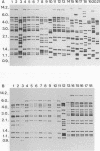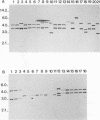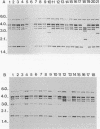Abstract
In order to describe the transmission of tuberculosis (TB) at the clonal level in a defined geographic region during a certain period of time, all isolates of Mycobacterium tuberculosis collected during 1992 from Greenland were subjected to analyses of DNA restriction fragment length polymorphism (RFLP). The RFLP patterns obtained by probing the genomic DNA with the repetitive insertion segment IS6110 revealed a high degree of similarity among the isolates, indicating a relatively high transmission rate and a close relationship between the individual M. tuberculosis clones. This was further confirmed by reprobing the Southern blots with two more-stable genetic markers, IS1081 and the DR sequence. The RFLP patterns were compared with those of 245 M. tuberculosis strains collected from Denmark during the same period (representing 91% of all new, bacteriologically verified cases of TB in Denmark in 1992). One of the three prevalent IS6110-defined clusters was traced to a group of immigrants from Greenland living in a small, defined geographical region in Denmark and to a group of Danish citizens either with known contact with these immigrants or, in other cases, with a record of previous travel or working activities in Greenland. The study showed that the present technique is extremely helpful in monitoring the spread of TB and thereby also contributing to improved disease control.
Full text
PDF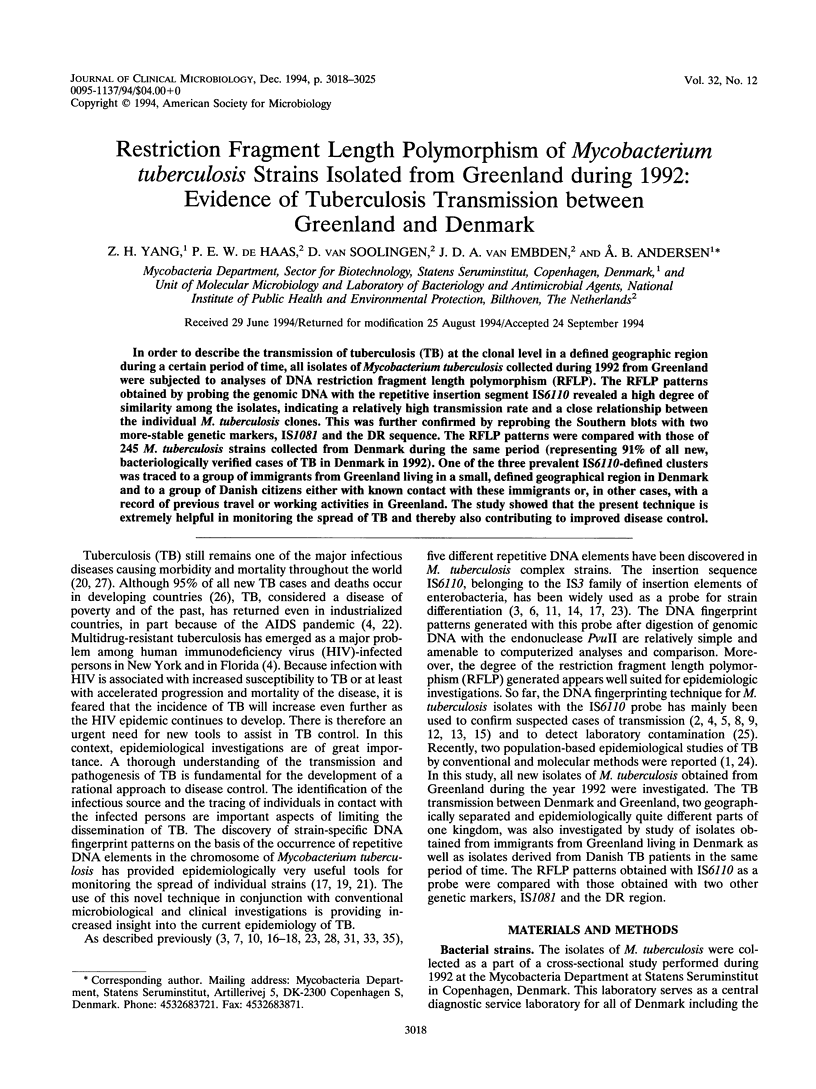
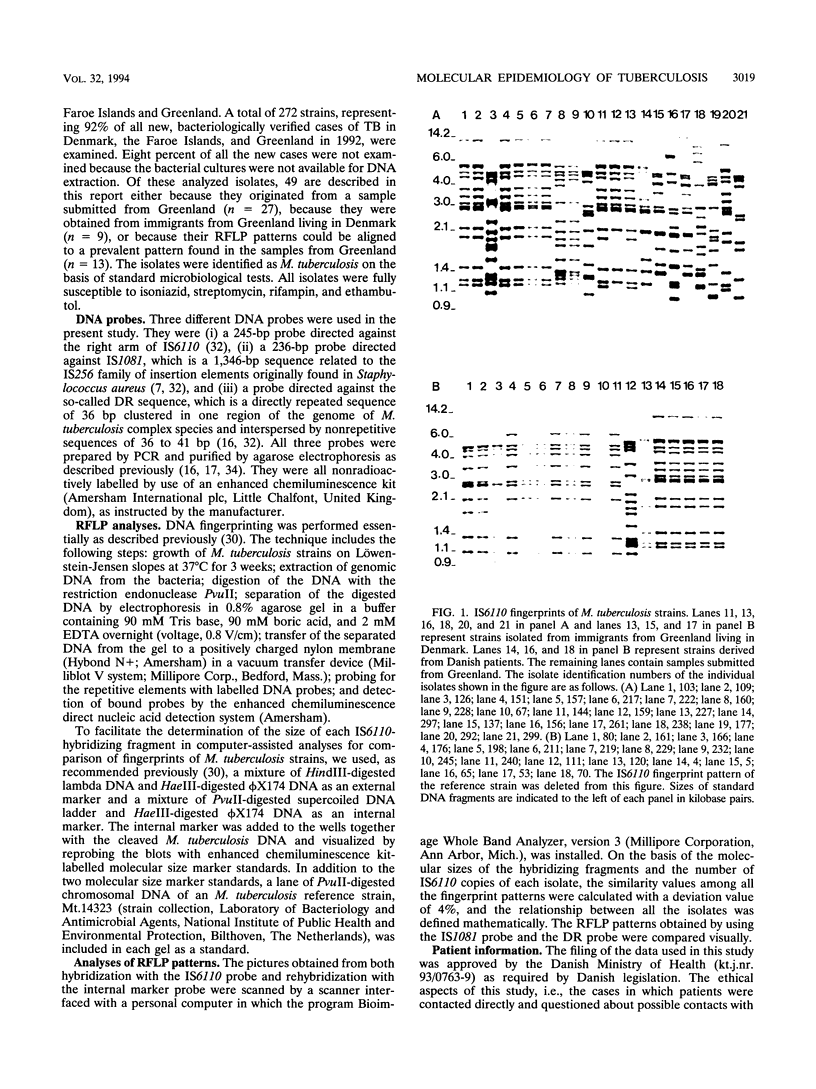
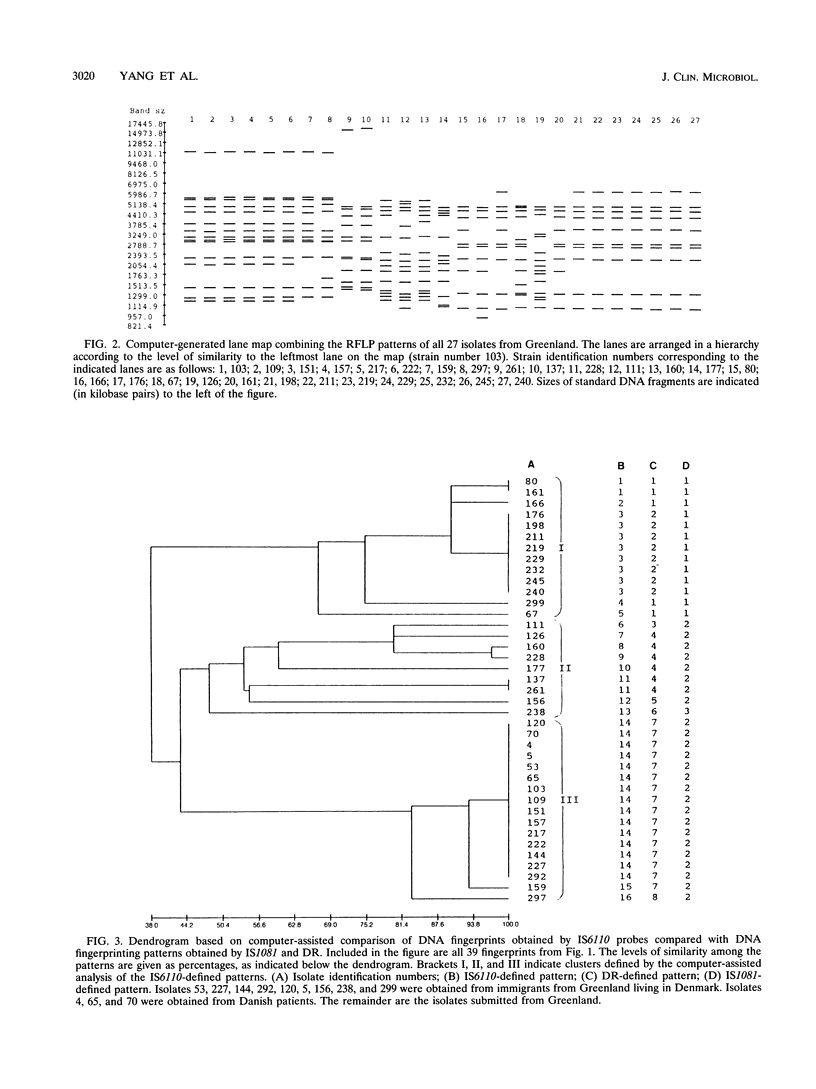
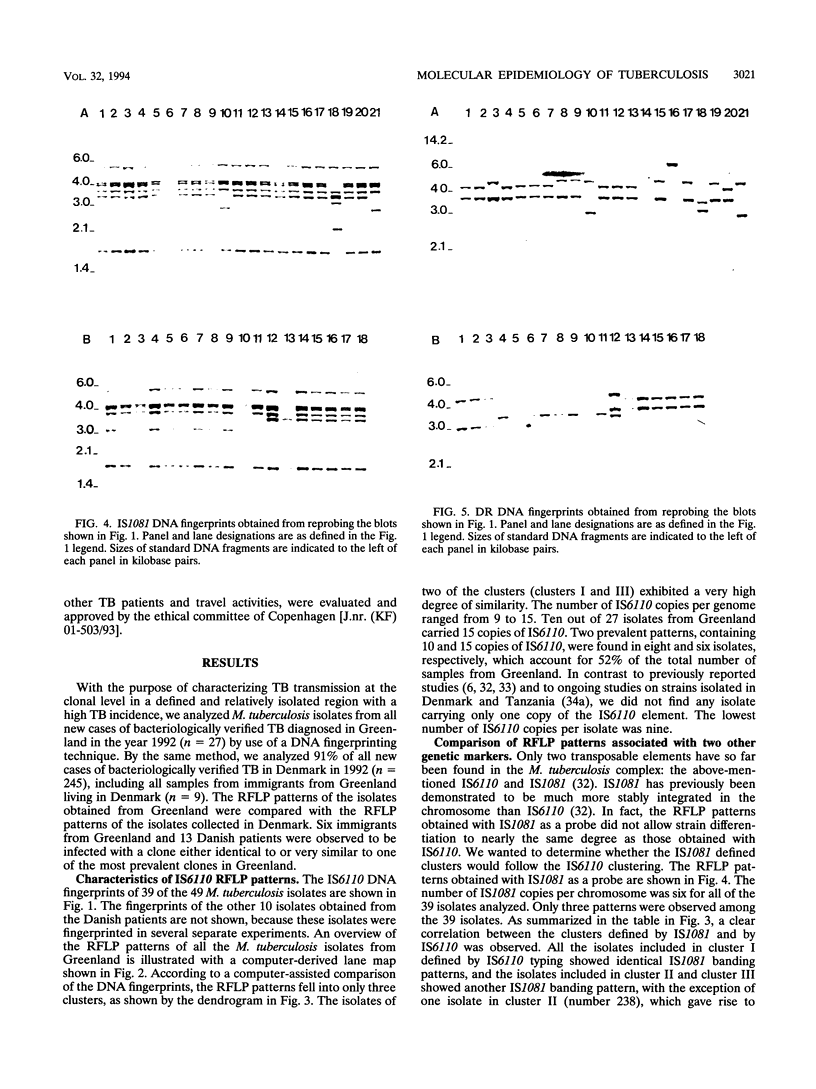
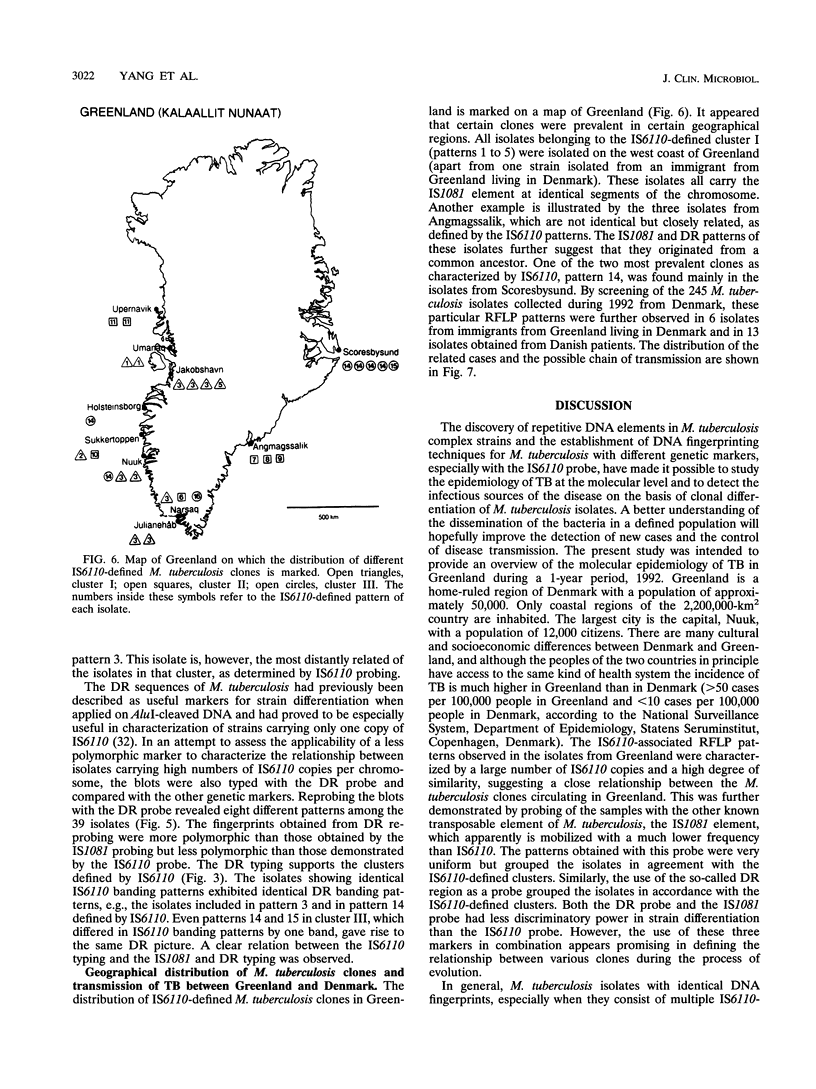
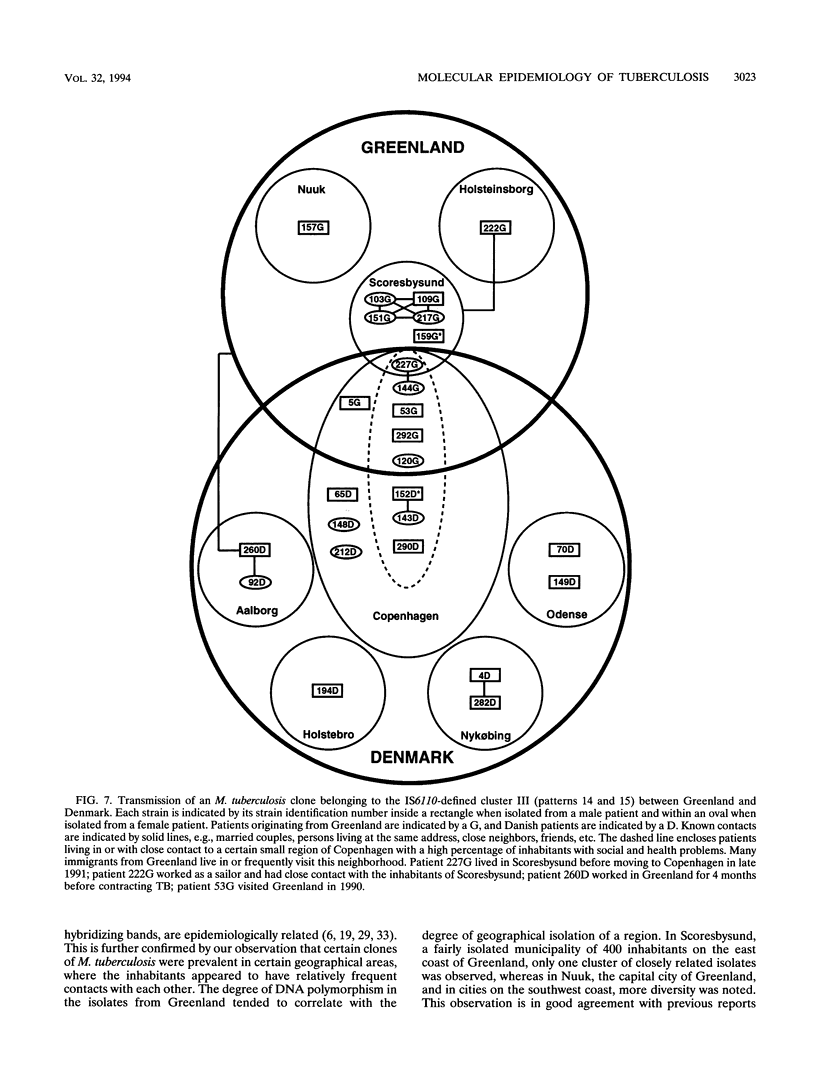
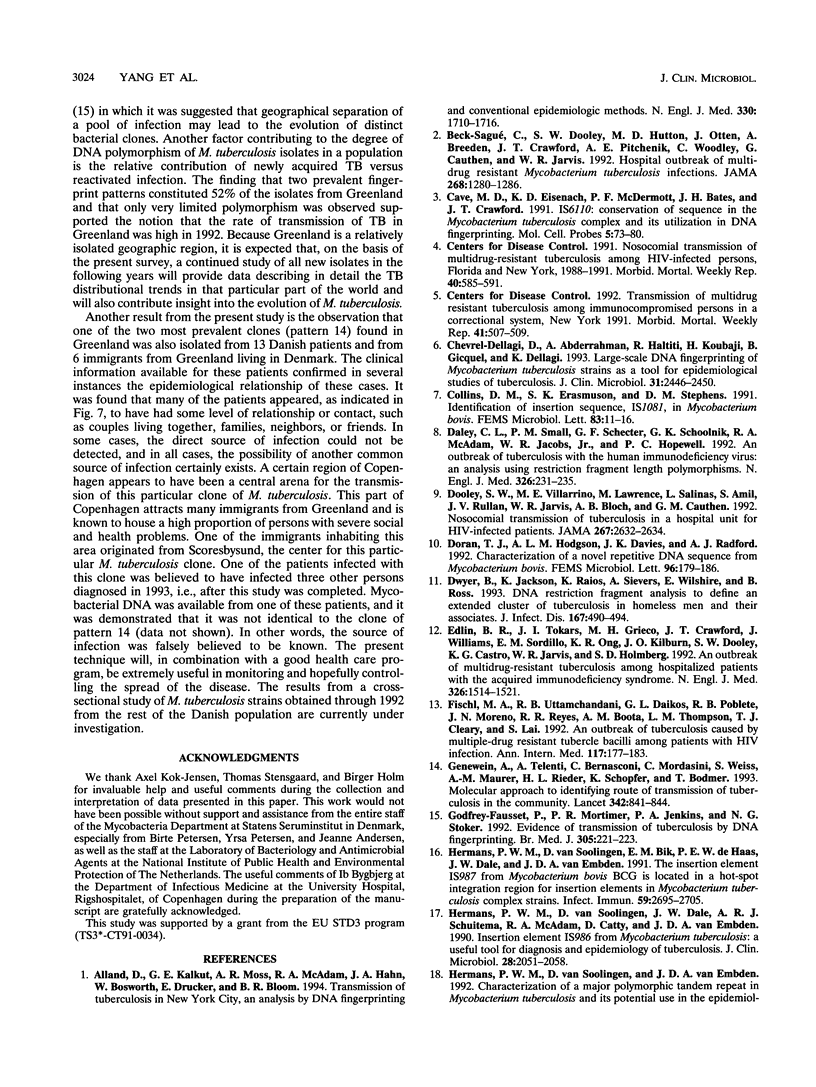
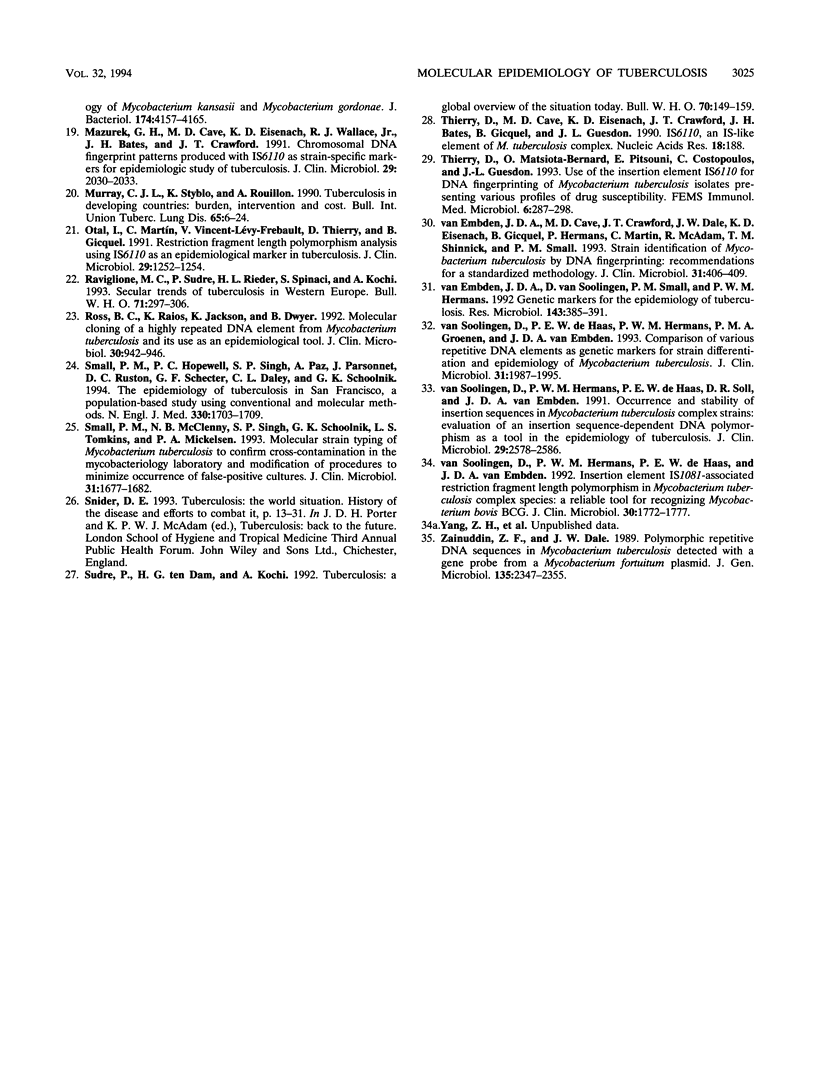
Images in this article
Selected References
These references are in PubMed. This may not be the complete list of references from this article.
- Alland D., Kalkut G. E., Moss A. R., McAdam R. A., Hahn J. A., Bosworth W., Drucker E., Bloom B. R. Transmission of tuberculosis in New York City. An analysis by DNA fingerprinting and conventional epidemiologic methods. N Engl J Med. 1994 Jun 16;330(24):1710–1716. doi: 10.1056/NEJM199406163302403. [DOI] [PubMed] [Google Scholar]
- Beck-Sagué C., Dooley S. W., Hutton M. D., Otten J., Breeden A., Crawford J. T., Pitchenik A. E., Woodley C., Cauthen G., Jarvis W. R. Hospital outbreak of multidrug-resistant Mycobacterium tuberculosis infections. Factors in transmission to staff and HIV-infected patients. JAMA. 1992 Sep 9;268(10):1280–1286. doi: 10.1001/jama.1992.03490100078031. [DOI] [PubMed] [Google Scholar]
- Cave M. D., Eisenach K. D., McDermott P. F., Bates J. H., Crawford J. T. IS6110: conservation of sequence in the Mycobacterium tuberculosis complex and its utilization in DNA fingerprinting. Mol Cell Probes. 1991 Feb;5(1):73–80. doi: 10.1016/0890-8508(91)90040-q. [DOI] [PubMed] [Google Scholar]
- Chevrel-Dellagi D., Abderrahman A., Haltiti R., Koubaji H., Gicquel B., Dellagi K. Large-scale DNA fingerprinting of Mycobacterium tuberculosis strains as a tool for epidemiological studies of tuberculosis. J Clin Microbiol. 1993 Sep;31(9):2446–2450. doi: 10.1128/jcm.31.9.2446-2450.1993. [DOI] [PMC free article] [PubMed] [Google Scholar]
- Collins D. M., Stephens D. M. Identification of an insertion sequence, IS1081, in Mycobacterium bovis. FEMS Microbiol Lett. 1991 Sep 15;67(1):11–15. doi: 10.1016/0378-1097(91)90435-d. [DOI] [PubMed] [Google Scholar]
- Daley C. L., Small P. M., Schecter G. F., Schoolnik G. K., McAdam R. A., Jacobs W. R., Jr, Hopewell P. C. An outbreak of tuberculosis with accelerated progression among persons infected with the human immunodeficiency virus. An analysis using restriction-fragment-length polymorphisms. N Engl J Med. 1992 Jan 23;326(4):231–235. doi: 10.1056/NEJM199201233260404. [DOI] [PubMed] [Google Scholar]
- Dooley S. W., Villarino M. E., Lawrence M., Salinas L., Amil S., Rullan J. V., Jarvis W. R., Bloch A. B., Cauthen G. M. Nosocomial transmission of tuberculosis in a hospital unit for HIV-infected patients. JAMA. 1992 May 20;267(19):2632–2634. [PubMed] [Google Scholar]
- Doran T. J., Hodgson A. L., Davies J. K., Radford A. J. Characterisation of a novel repetitive DNA sequence from Mycobacterium bovis. FEMS Microbiol Lett. 1992 Sep 15;75(2-3):179–185. doi: 10.1016/0378-1097(92)90400-i. [DOI] [PubMed] [Google Scholar]
- Dwyer B., Jackson K., Raios K., Sievers A., Wilshire E., Ross B. DNA restriction fragment analysis to define an extended cluster of tuberculosis in homeless men and their associates. J Infect Dis. 1993 Feb;167(2):490–494. doi: 10.1093/infdis/167.2.490. [DOI] [PubMed] [Google Scholar]
- Edlin B. R., Tokars J. I., Grieco M. H., Crawford J. T., Williams J., Sordillo E. M., Ong K. R., Kilburn J. O., Dooley S. W., Castro K. G. An outbreak of multidrug-resistant tuberculosis among hospitalized patients with the acquired immunodeficiency syndrome. N Engl J Med. 1992 Jun 4;326(23):1514–1521. doi: 10.1056/NEJM199206043262302. [DOI] [PubMed] [Google Scholar]
- Fischl M. A., Uttamchandani R. B., Daikos G. L., Poblete R. B., Moreno J. N., Reyes R. R., Boota A. M., Thompson L. M., Cleary T. J., Lai S. An outbreak of tuberculosis caused by multiple-drug-resistant tubercle bacilli among patients with HIV infection. Ann Intern Med. 1992 Aug 1;117(3):177–183. doi: 10.7326/0003-4819-117-3-177. [DOI] [PubMed] [Google Scholar]
- Genewein A., Telenti A., Bernasconi C., Mordasini C., Weiss S., Maurer A. M., Rieder H. L., Schopfer K., Bodmer T. Molecular approach to identifying route of transmission of tuberculosis in the community. Lancet. 1993 Oct 2;342(8875):841–844. doi: 10.1016/0140-6736(93)92698-s. [DOI] [PubMed] [Google Scholar]
- Godfrey-Faussett P., Mortimer P. R., Jenkins P. A., Stoker N. G. Evidence of transmission of tuberculosis by DNA fingerprinting. BMJ. 1992 Jul 25;305(6847):221–223. doi: 10.1136/bmj.305.6847.221. [DOI] [PMC free article] [PubMed] [Google Scholar]
- Hermans P. W., van Soolingen D., Bik E. M., de Haas P. E., Dale J. W., van Embden J. D. Insertion element IS987 from Mycobacterium bovis BCG is located in a hot-spot integration region for insertion elements in Mycobacterium tuberculosis complex strains. Infect Immun. 1991 Aug;59(8):2695–2705. doi: 10.1128/iai.59.8.2695-2705.1991. [DOI] [PMC free article] [PubMed] [Google Scholar]
- Hermans P. W., van Soolingen D., Dale J. W., Schuitema A. R., McAdam R. A., Catty D., van Embden J. D. Insertion element IS986 from Mycobacterium tuberculosis: a useful tool for diagnosis and epidemiology of tuberculosis. J Clin Microbiol. 1990 Sep;28(9):2051–2058. doi: 10.1128/jcm.28.9.2051-2058.1990. [DOI] [PMC free article] [PubMed] [Google Scholar]
- Hermans P. W., van Soolingen D., van Embden J. D. Characterization of a major polymorphic tandem repeat in Mycobacterium tuberculosis and its potential use in the epidemiology of Mycobacterium kansasii and Mycobacterium gordonae. J Bacteriol. 1992 Jun;174(12):4157–4165. doi: 10.1128/jb.174.12.4157-4165.1992. [DOI] [PMC free article] [PubMed] [Google Scholar]
- Mazurek G. H., Cave M. D., Eisenach K. D., Wallace R. J., Jr, Bates J. H., Crawford J. T. Chromosomal DNA fingerprint patterns produced with IS6110 as strain-specific markers for epidemiologic study of tuberculosis. J Clin Microbiol. 1991 Sep;29(9):2030–2033. doi: 10.1128/jcm.29.9.2030-2033.1991. [DOI] [PMC free article] [PubMed] [Google Scholar]
- Murray C. J., Styblo K., Rouillon A. Tuberculosis in developing countries: burden, intervention and cost. Bull Int Union Tuberc Lung Dis. 1990 Mar;65(1):6–24. [PubMed] [Google Scholar]
- Otal I., Martín C., Vincent-Lévy-Frebault V., Thierry D., Gicquel B. Restriction fragment length polymorphism analysis using IS6110 as an epidemiological marker in tuberculosis. J Clin Microbiol. 1991 Jun;29(6):1252–1254. doi: 10.1128/jcm.29.6.1252-1254.1991. [DOI] [PMC free article] [PubMed] [Google Scholar]
- Raviglione M. C., Sudre P., Rieder H. L., Spinaci S., Kochi A. Secular trends of tuberculosis in western Europe. Bull World Health Organ. 1993;71(3-4):297–306. [PMC free article] [PubMed] [Google Scholar]
- Ross B. C., Raios K., Jackson K., Dwyer B. Molecular cloning of a highly repeated DNA element from Mycobacterium tuberculosis and its use as an epidemiological tool. J Clin Microbiol. 1992 Apr;30(4):942–946. doi: 10.1128/jcm.30.4.942-946.1992. [DOI] [PMC free article] [PubMed] [Google Scholar]
- Small P. M., Hopewell P. C., Singh S. P., Paz A., Parsonnet J., Ruston D. C., Schecter G. F., Daley C. L., Schoolnik G. K. The epidemiology of tuberculosis in San Francisco. A population-based study using conventional and molecular methods. N Engl J Med. 1994 Jun 16;330(24):1703–1709. doi: 10.1056/NEJM199406163302402. [DOI] [PubMed] [Google Scholar]
- Small P. M., McClenny N. B., Singh S. P., Schoolnik G. K., Tompkins L. S., Mickelsen P. A. Molecular strain typing of Mycobacterium tuberculosis to confirm cross-contamination in the mycobacteriology laboratory and modification of procedures to minimize occurrence of false-positive cultures. J Clin Microbiol. 1993 Jul;31(7):1677–1682. doi: 10.1128/jcm.31.7.1677-1682.1993. [DOI] [PMC free article] [PubMed] [Google Scholar]
- Sudre P., ten Dam G., Kochi A. Tuberculosis: a global overview of the situation today. Bull World Health Organ. 1992;70(2):149–159. [PMC free article] [PubMed] [Google Scholar]
- Thierry D., Cave M. D., Eisenach K. D., Crawford J. T., Bates J. H., Gicquel B., Guesdon J. L. IS6110, an IS-like element of Mycobacterium tuberculosis complex. Nucleic Acids Res. 1990 Jan 11;18(1):188–188. doi: 10.1093/nar/18.1.188. [DOI] [PMC free article] [PubMed] [Google Scholar]
- Thierry D., Matsiota-Bernard P., Pitsouni E., Costopoulos C., Guesdon J. L. Use of the insertion element IS6110 for DNA fingerprinting of Mycobacterium tuberculosis isolates presenting various profiles of drug susceptibility. FEMS Immunol Med Microbiol. 1993 Apr;6(4):287–297. doi: 10.1111/j.1574-695X.1993.tb00341.x. [DOI] [PubMed] [Google Scholar]
- Zainuddin Z. F., Dale J. W. Polymorphic repetitive DNA sequences in Mycobacterium tuberculosis detected with a gene probe from a Mycobacterium fortuitum plasmid. J Gen Microbiol. 1989 Sep;135(9):2347–2355. doi: 10.1099/00221287-135-9-2347. [DOI] [PubMed] [Google Scholar]
- van Embden J. D., Cave M. D., Crawford J. T., Dale J. W., Eisenach K. D., Gicquel B., Hermans P., Martin C., McAdam R., Shinnick T. M. Strain identification of Mycobacterium tuberculosis by DNA fingerprinting: recommendations for a standardized methodology. J Clin Microbiol. 1993 Feb;31(2):406–409. doi: 10.1128/jcm.31.2.406-409.1993. [DOI] [PMC free article] [PubMed] [Google Scholar]
- van Embden J. D., van Soolingen D., Small P. M., Hermans P. W. Genetic markers for the epidemiology of tuberculosis. Res Microbiol. 1992 May;143(4):385–391. doi: 10.1016/0923-2508(92)90051-o. [DOI] [PubMed] [Google Scholar]
- van Soolingen D., Hermans P. W., de Haas P. E., Soll D. R., van Embden J. D. Occurrence and stability of insertion sequences in Mycobacterium tuberculosis complex strains: evaluation of an insertion sequence-dependent DNA polymorphism as a tool in the epidemiology of tuberculosis. J Clin Microbiol. 1991 Nov;29(11):2578–2586. doi: 10.1128/jcm.29.11.2578-2586.1991. [DOI] [PMC free article] [PubMed] [Google Scholar]
- van Soolingen D., Hermans P. W., de Haas P. E., van Embden J. D. Insertion element IS1081-associated restriction fragment length polymorphisms in Mycobacterium tuberculosis complex species: a reliable tool for recognizing Mycobacterium bovis BCG. J Clin Microbiol. 1992 Jul;30(7):1772–1777. doi: 10.1128/jcm.30.7.1772-1777.1992. [DOI] [PMC free article] [PubMed] [Google Scholar]
- van Soolingen D., de Haas P. E., Hermans P. W., Groenen P. M., van Embden J. D. Comparison of various repetitive DNA elements as genetic markers for strain differentiation and epidemiology of Mycobacterium tuberculosis. J Clin Microbiol. 1993 Aug;31(8):1987–1995. doi: 10.1128/jcm.31.8.1987-1995.1993. [DOI] [PMC free article] [PubMed] [Google Scholar]



